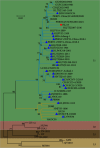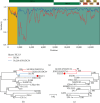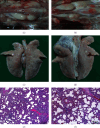Isolation, Pathogenicity, and Comparative Phylogenetic Characteristics of an Intralineage Recombinant NADC34-Like PRRSV in China
- PMID: 40303755
- PMCID: PMC12017108
- DOI: 10.1155/2023/9929573
Isolation, Pathogenicity, and Comparative Phylogenetic Characteristics of an Intralineage Recombinant NADC34-Like PRRSV in China
Abstract
Porcine reproductive and respiratory syndrome (PRRS), which causes reproductive failure in sows and respiratory symptoms in piglets, poses a significant threat to the global pig industry. PRRS virus (PRRSV) variants continue to emerge and spread among pigs. NADC34-like PRRSV has been imported into China in recent years and has shown potential as an endemic strain, which is of great concern. In this study, a NADC34-like PRRSV, named HLJ13 strain, was isolated from a farm where pigs experienced respiratory symptoms and abortions. Genomic analysis revealed that the HLJ13 strain was a potential recombinant of NADC34-like and NADC30-like strains, and the restriction fragment length polymorphism of HLJ13 was a novel pattern that was not yet listed. In the PRRSV HLJ13-inoculated group, the piglets showed mild clinical symptoms, such as persistent fever, and showed histopathological lesions in the lungs, and the virus was detectable at 3 and 7 days postinoculation in anal and nasal swabs, respectively. Recombination analysis revealed that interlineage recombinant events were detected in 8 out of 27 Chinese NADC34-like PRRSVs. Phylogenetic analysis showed that Chinese NADC34-like PRRSVs were distributed in two clades of lineage 1, and Chinese NADC34-like PRRSVs showed different N-glycosylation modifications in glycoproteins, especially in GP3 and GP5. These findings shed light on the genomic characteristics and pathogenicity of the NADC34-like PRRSV in China.
Copyright © 2023 Da-Song Xia et al.
Conflict of interest statement
The authors declare that they have no conflicts of interest.
Figures









Similar articles
-
Molecular Characteristics and Pathogenicity of a Novel Recombinant Porcine Reproductive and Respiratory Syndrome Virus Strain from NADC30-, NADC34-, and JXA1-Like Strains That Emerged in China.Microbiol Spectr. 2022 Dec 21;10(6):e0266722. doi: 10.1128/spectrum.02667-22. Epub 2022 Nov 10. Microbiol Spectr. 2022. PMID: 36354339 Free PMC article.
-
Comparative Genomic and Biological Investigation of NADC30- and NADC34-Like PRRSV Strains Isolated in South Korea.Transbound Emerg Dis. 2025 Jan 22;2025:9015349. doi: 10.1155/tbed/9015349. eCollection 2025. Transbound Emerg Dis. 2025. PMID: 40302751 Free PMC article.
-
Phylogenetics, Genomic Recombination, and NSP2 Polymorphic Patterns of Porcine Reproductive and Respiratory Syndrome Virus in China and the United States in 2014-2018.J Virol. 2020 Feb 28;94(6):e01813-19. doi: 10.1128/JVI.01813-19. Print 2020 Feb 28. J Virol. 2020. PMID: 31896589 Free PMC article.
-
Recent advances in the study of NADC34-like porcine reproductive and respiratory syndrome virus in China.Front Microbiol. 2022 Jul 22;13:950402. doi: 10.3389/fmicb.2022.950402. eCollection 2022. Front Microbiol. 2022. PMID: 35935186 Free PMC article. Review.
-
The prevalent status and genetic diversity of porcine reproductive and respiratory syndrome virus in China: a molecular epidemiological perspective.Virol J. 2018 Jan 4;15(1):2. doi: 10.1186/s12985-017-0910-6. Virol J. 2018. PMID: 29301547 Free PMC article. Review.
Cited by
-
A novel L1C.5 RFLP-1-4-4 recombinant porcine reproductive and respiratory syndrome virus between wild-type virus and a modified-live virus vaccine is highly pathogenic to piglets.Front Vet Sci. 2025 Jul 2;12:1627238. doi: 10.3389/fvets.2025.1627238. eCollection 2025. Front Vet Sci. 2025. PMID: 40671821 Free PMC article.
-
A Spanish Porcine Reproductive and Respiratory Syndrome Virus 1 Strain Is Highly Virulent in Pigs Under Experimental Conditions.Transbound Emerg Dis. 2025 May 23;2025:4847981. doi: 10.1155/tbed/4847981. eCollection 2025. Transbound Emerg Dis. 2025. PMID: 40453458 Free PMC article.
References
MeSH terms
LinkOut - more resources
Full Text Sources
Miscellaneous

